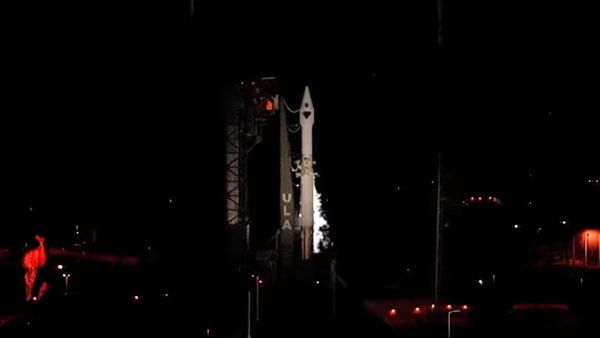A nearly billion-dollar NASA spacecraft named Lucy officially launched on Saturday morning, in what is the beginning of a 12-year journey to explore eight different asteroids.
The trojan asteroid, also called Trojan planet, any one of a number of asteroids that occupy a stable Lagrangian point in a planet's orbit around the Sun.
The spaceship will be the first to tour the so-called Trojan asteroids that orbit Jupiter and are 'time capsules from the birth of our Solar System,' according to NASA scientists from the Goddard Space Center in Greenbelt, Maryland.
NASA says the Lucy space mission will revolutionize our knowledge of planetary origins and the formation of the solar system, giving insight into planetary evolution.
Lucy launched into orbit on Saturday at 5:34 am on a United Launch Alliance Atlas V rocket from Cape Canaveral Space Force Station in Florida.
The $981 million mission spaceship also carries a plaque that includes quotes from the likes of Carl Sagan, Albert Einstein and the Beatles.
As it happens, the mission takes its name from the fossilized human ancestor, named 'Lucy' by her discovers, whose skeleton provided unique insights into our evolution, as well as the song 'Lucy in the Sky with Diamonds' by aforementioned The Beatles.
In a prerecorded video for NASA, Beatles drummer Ringo Starr paid tribute to his late bandmate John Lennon, who wrote the song that helped inspire the ship's name.
'I'm so excited — Lucy is going back in the sky with diamonds. Johnny will love that,' Starr said.
'Anyway, if you meet anyone up there, Lucy, give them peace and love from me.'
Meet the 8 asteroids NASA's Lucy spacecraft will visit https://t.co/WNydmkB5nK pic.twitter.com/CO0NXLiLVf
— SPACE.com (@SPACEdotcom) October 16, 2021
On Thursday, Lucy, along with the United Launch Alliance Atlas V rocket, was rolled out of the Vertical Integration Facility to the launch pad at Space Launch Complex 41.
To make it work, NASA had to convert the booster, removing two solid rocket motors and replacing features designed to work with a crew capsule.
'I think overall it ended up in a situation that worked out really well,' ULA Chief Operating Officer John Elbon said of the change.
Thanks to the NASA team, Lucy was able to launch on Saturday morning as scheduled.
Now that it has launched, Lucy will fly around the Earth twice to adjust its trajectory and get it on its way to the outer parts of the solar system.
Its first asteroid visit will be in April 2025, when it will take a look at a main-belt asteroid called DonaldJohanson, named after the paleoanthropologist behind the fossil Lucy discovery, Donald Johanson.
NASA's Lucy asteroid probe has a time capsule plaque with messages to future humans https://t.co/02D96vi7Zx pic.twitter.com/R59III8UWe
— SPACE.com (@SPACEdotcom) October 16, 2021
Johanson said he had goosebumps watching Lucy take flight— 'I will never look at Jupiter the same ... absolutely mind-expanding.' He said he was filled with wonder about this 'intersection of our past, our present, and our future.'
'That a human ancestor who lived so long ago stimulated a mission which promises to add valuable information about the formation of our solar system is incredibly exciting,' said Johanson, of Arizona State University, who traveled to Cape Canaveral for his first rocket launch according to AOL.
Meanwhile, the first Trojan asteroid flyby will not happen for another two years, when Lucy gets closer to Jupiter in August 2027.
? Lucy lifted off at 5:34am ET to begin its voyage to explore the Trojan asteroids.
— NASA's Kennedy Space Center (@NASAKennedy) October 16, 2021
Next up will be separation of the Lucy spacecraft from Centaur. Live mission coverage continues on @NASA TV: https://t.co/A9sbAYbCl3 pic.twitter.com/39ekIowm2w
The vast majority of the asteroid visits will happen in 2027 and 2028, with a final asteroid flyby scheduled to happen in March 2033.
As well as viewing some of the oldest rocks in the solar system, Lucy's path will cross the Earth three times, as it uses our planet's gravity to aid in its positioning.
This move will make it the first-ever spacecraft to return to Earth from the outer solar system, as all others are either still going - in the case of the Viking probes - or burnt up in the atmosphere of a gas giant, as was the case with Cassini and Saturn.
The Lucy mission probe is 51.8ft wide and 46ft from top to bottom and comes equipped with solar panels on each side that help power its instruments.
These instruments include a color visible imager, a thermal emission spectrometer, and an infrared imaging spectrometer.
The thermal emission spectrometer, known as L'TES, measures the surface temperature of the Trojan asteroids by observing the thermal infrared spectrum, helping to understand the physical properties of the surface material.
Lucy Long Range Reconnaissance Imager (L'LORRI), is a high-resolution visible camera that will provide the most detailed images of the surface of the asteroids.
Wonderful ! Success in the launch of Lucy: an important NASA’s probe with crucial targets:
— Xavi Bros (@Xavi_Bros) October 16, 2021
7 flybyes to asteroids, one to a main-belt one and 6 more to a troyan asteroids !pic.twitter.com/1S70LCJMt6
Then there is L'Ralph, the final of the three instruments, which will reveal the absorption lines that serve as the fingerprints for different silicates, ices, and organics that may be on the surface of the Trojan asteroids.
L'Ralph also has a visible imaging camera that will take color pictures of the asteroids to help scientists determine what they are made of.
'This team has put in so much work to build a spacecraft that is truly a work of art,' said Donya Douglas-Bradshaw, the Lucy project manager, adding 'it's been powered on, the team is monitoring it and we are ready to launch.'








